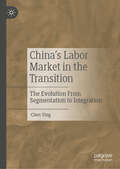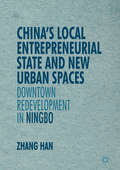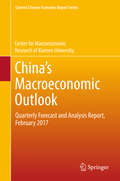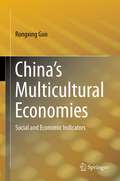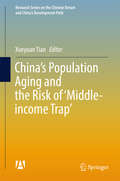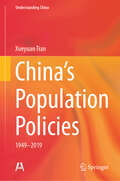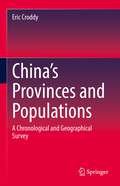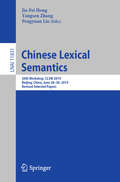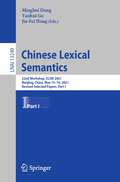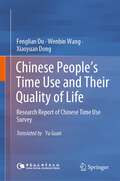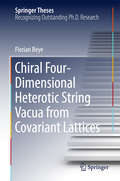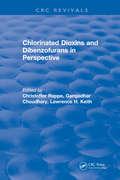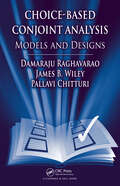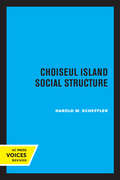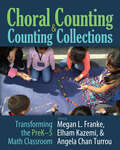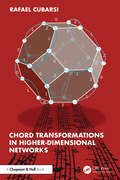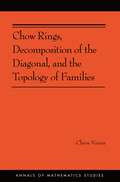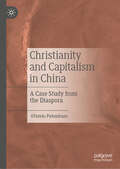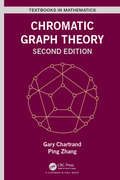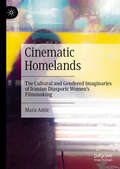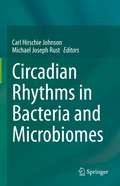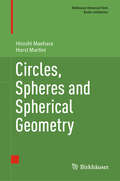- Table View
- List View
China’s Labor Market in the Transition: The Evolution From Segmentation to Integration
by Chen YingThis book explores the dynamics of the Chinese labor market, the largest in the world. The sheer scale of rural laborers living in cities is the ultimate engine driving the fastest urbanization the world has ever seen. Today, the country faces a series of new challenges as it tries to address problems of unemployment and under-employment. These include population ageing, automation, the increasing use of AI on the factory floor and other workplaces and Chinese manufacturers’ move up the value chain. The book presents an empirically rich and analytically rigorous account of how these challenges might be met. It will be of interest to labor economists, scholars of Chinese manufacturing, and researchers of the Chinese economy.
China’s Local Entrepreneurial State and New Urban Spaces: Downtown Redevelopment in Ningbo (New Perspectives on Chinese Politics and Society)
by Han ZhangIn this book, the author seeks to understand China’s urban redevelopment from the theoretical perspective of the local entrepreneurial state. China’s rapid socio-economic transformations since 1978 have been in large part attributed to China’s state transformations. The author closely investigates Ningbo’s two downtown redevelopment projects by conducting ethnographic fieldwork and documentary research. It is found that the local entrepreneurial state deploys local state enterprises to undertake strategic urban redevelopment projects, organizes high-profile city/district marketing campaigns in entrepreneurial manners, and develops corporatist intermediations with local business owners for collaborative urban governance. Yet the local entrepreneurial state is multi-layered, with the municipal and district authorities sometimes disagreeing, conflicting, and bargaining with each other. Meanwhile, the relationship between spaces and their users, as well as that between various space users, constantly changes. All these players and their interactions constitute “spatial politics”, or the story of conflicts, struggles, negotiations, and collaborations in urban governance. This work, based on six months of fieldwork, will appeal to scholars in the social sciences and experts in Asian Studies.
China’s Macroeconomic Outlook: Quarterly Forecast and Analysis Report, February 2017 (Current Chinese Economic Report Series)
by Center for Macroeconomic Research of Xiamen UniversityThis book is a quarterly forecast and analysis report on the Chinese economy. It is published twice a year and presents ongoing results from the "China Quarterly Macroeconomic Model (CQMM)," a research project at the Center for Macroeconomic Research (CMR) at Xiamen University. Based on the CQMM, the research team forecasts China's major macroeconomic indicators for the next 8 quarters, including GDP growth rate, CPI, PPI, investment in fixed assets, household consumption, imports, exports, and foreign reserves. Moreover, it simulates different scenarios to study the effects of macroeconomic policy on the Chinese economy. In addition to helping readers to understand China's economic trends and policies, this book has three main goals: to help readers understand China's economic performance; to forecast the major macroeconomic indicators for the next 8 quarters; and to simulate the effectiveness of macroeconomic policy.
China’s Multicultural Economies: Social and Economic Indicators
by Rongxing GuoAlthough the majority of China's population is of the Han nationality (which accounts for more than 90% of China's population), the non-Han ethnic groups have a population of more than 100 million. Until now, China has officially identified, except for other unknown ethnic groups and foreigners with Chinese citizenship, 56 ethnic groups. In addition, ethnic groups vary widely in size. With a population of more than 15 million, the Zhuang have the largest ethnic minority, and the Lhoba, with only two thousand or more, the smallest. China's ethnic diversity has resulted in a special socioeconomic landscape of China itself. This book develops a complete socioeconomic picture and a detailed and comparable set of data for each of China's ethnic groups. There have not been any precise data on China's socioeconomic statistics from multi-ethnic dimension. The only official data released can be found in China Ethnic Statistical Yearbook (released by the State Commission of Ethnic Affairs (SCEA) of the People's Republic of China since 1994). However, as this Yearbook has only reported the socioeconomic statistics for the minority-based autonomous areas, a complete set of China's multi-ethnic data cannot be derived from it. This book provides a broad collection of data on China's 56 ethnic groups and profiles the demography, cultural, economy, and business climates for each of China's diverse ethnic groups.
China’s Population Aging and the Risk of ‘Middle-income Trap’ (Research Series on the Chinese Dream and China’s Development Path)
by Xueyuan TianThis book includes a series of reports that mainly discuss the Middle Income Trap against the backdrop of population ageing in China. It also offers practical suggestions on how to avoid it properly. Concretely, it argues that the government should accelerate the transition of economic development modes, resolve concentrated social conflicts, promote a balanced rural and urban development during the process of urbanization, and mitigate the effects of population ageing by fostering strengths and avoiding weaknesses. As for the challenges posed by population ageing in China, it puts forward five core suggestions tailored to China's unique situation. Assessing a number of real-world challenges, the general report and the special reports combine theory and empirical findings, using primary data for their analyses. Given the wealth of essential information it provides, the book offers a valuable reference resource for decision-makers.
China’s Population Policies: 1949–2019 (Understanding China)
by Xueyuan TianThis book presents a factual analysis of the history of population policy, especially the fertility policy, mainly the reproduction of the policy since the founding of New China, especially the promotion of one child per couple, including the background of the policy's introduction, the formulation of the decision, the prediction of possible problems, and the choice of decision to deal with them. It summarises the basic experience of China and the international community in implementing population policies, and proposes to follow the path of family planning with Chinese characteristics and implement population policies that are compatible with it.
China’s Provinces and Populations: A Chronological and Geographical Survey
by Eric CroddyThis manual provides an overview of China's administrative geography, history, and populations of all 31 provinces, as well as Hong Kong, Macao and Taiwan. It focuses primarily on how the provinces came to be, how they were named, as well as their people and populations throughout history. In addition to extensive use of bilingual names (Chinese-English) for specificity, this resource is unique in the datasets contained therein: (1) Up-to-date residential populations of mainland China using the latest decennial (2020) census, and (2) political-administrative registered household (hukou) data based on official numbers provided by People’s Republic of China (PRC) Ministry of Public Security showing trends from 2012-2020. Each internally consistent, but differing in their methodologies, whereby the Census (decennial) data provide a snapshot of how many people live in a given location, and the permanent (hukou) registered household data track each individual based on their hometown, household, urban/rural status, and nationality. This book addresses this chasm which, among other issues, points to the phenomenon of China’s "floating populations", where millions of Chinese spend much if not all of their time living, working, and studying outside their home provinces. By showing how the Chinese have been populated and their organization throughout history, this manual is the go to place for professionals, practitioners and academics working and interested in China’s provinces and populations.
Chinese Lexical Semantics: 20th Workshop, CLSW 2019, Beijing, China, June 28–30, 2019, Revised Selected Papers (Lecture Notes in Computer Science #11831)
by Jia-Fei Hong Yangsen Zhang Pengyuan LiuThis book constitutes the thoroughly refereed post-workshop proceedings of the 20th Chinese Lexical Semantics Workshop, CLSW 2019, held in Chiayi, Taiwan, in June 2019. The 39 full papers and 46 short papers included in this volume were carefully reviewed and selected from 254 submissions. They are organized in the following topical sections: lexical semantics; applications of natural language processing; lexical resources; corpus linguistics.
Chinese Lexical Semantics: 22nd Workshop, CLSW 2021, Nanjing, China, May 15–16, 2021, Revised Selected Papers, Part I (Lecture Notes in Computer Science #13249)
by Jia-Fei Hong Minghui Dong Yanhui GuThe two-volume proceedings, LNCS 13249 and 13250, constitutes the thoroughly refereed post-workshop proceedings of the 22nd Chinese Lexical Semantics Workshop, CLSW 2021, held in Nanjing, China in May 2021. The 68 full papers and 4 short papers were carefully reviewed and selected from 261 submissions. They are organized in the following topical sections: Lexical Semantics and General Linguistics; Natural Language Processing and Language Computing; Cognitive Science and Experimental Studies; Lexical Resources and Corpus Linguistics.
Chinese Mathematical Astrology: Reaching Out to the Stars (Needham Research Institute Series)
by Ho Peng YokeThough there are a number of well-written works on Chinese divination, there are none that deal with the three sophisticated devices that were employed by the Chinese Astronomical Bureau in the eleventh century and for hundreds of years thereafter. Chinese experts applied the methods associated with these devices to both weather forecasting and to the interpretation of human affairs. Hidden by a veil of secrecy, these methods have always been relatively little known other than by their names. The first work in any language to explore these three methods, known as sanshi (three cosmic boards), this book sheds light on a topic which has been shrouded in mystery for centuries, having been kept secret for many years by the Chinese Astronomical Bureau.
Chinese People’s Time Use and Their Quality of Life: Research Report of Chinese Time Use Survey
by Wenbin Wang Fenglian Du Xiaoyuan DongThis book analyzes how Chinese people use their time, including how busy Chinese seek a healthy work-life balance, how some children win from the outset in terms of education, and how people pursue quality of life outside of or after work. General readers will get a vivid and detailed impression of the way Chinese people spend their time, while researchers will find a wealth of phenomena and data for analysis from both economic and social perspectives. The research presented here was conducted in the context of the Chinese Time Use Survey (CTUS), a nationwide initiative launched by Inner Mongolia University in 2017. The CTUS covers 29 Chinese provinces, and the database contains the time use information of 30,591 people aged 3 years and over from 12,471 households. The survey collects information at three main levels: personal, family and community.
Chinese Students' Higher Achievement in Mathematics: Comparison of Mathematics Education of Australian and Chinese Primary Schools (Mathematics Education – An Asian Perspective #0)
by Dacheng ZhaoThis book shares insights into the achievement gap in mathematics between East Asian and Western countries, and the ways to improve students' mathematics achievements. Especially, it highlights the importance to integrate case studies with large-scale international comparative studies in general, and comparative studies of mathematics education in particular. This book is a must-read for mathematics teachers, mathematics educators, educational researchers, education administrators, curriculum developers, assessment designers, and student teachers who are interested in mathematics education and how to improve students' mathematics achievements.
Chiral Four-Dimensional Heterotic String Vacua from Covariant Lattices (Springer Theses)
by Florian BeyeThis book is placed at the interface between string theory and elementary particle physics and shows novel results in the search for a heterotic string vacuum that reproduces those matter particles and interactions observed in our universe. The author provides a systematic classification of potentially realistic heterotic covariant lattice vacua, which possess a lower number of moduli fields when compared to conventional compactification methods, by means of number theoretical methods. These methods, while well known to the mathematics community, have not yet found many applications to physics. They are introduced to the degree necessary to understand the computations carried out throughout this work. Furthermore, explicit covariant lattice models with particularly interesting properties are analyzed in detail. Finally, new light is shed on the relation between covariant lattice models and asymmetric orbifold compactifications, the result being a concrete correspondence between certain types of asymmetric orbifolds and those classified covariant lattices.
Chlorinated Dioxins and Dibenzofurans in Perspective
by Christoffer RappeThis volume was developed from the proceedings of a symposium held in Miami Beach, at the 189th National Meeting of the American Chemical Society.It is the result of the combined efforts of many experts whose efforts have advanced our knowledge of the production, analysis, distribution, effects and control of chlorinated dioxins, dibenzofurans and related compounds.This is the third in a series of publications originating from current technology presented at national meetings of the American Chemical Society. Using this forum as a catalyst, researchers from all over the world came together to present and discuss their data and plan future work in this rapidly developing and sometimes highly emotional technical area.
Choice-Based Conjoint Analysis: Models and Designs
by Damaraju Raghavarao James B. Wiley Pallavi ChitturiConjoint analysis (CA) and discrete choice experimentation (DCE) are tools used in marketing, economics, transportation, health, tourism, and other areas to develop and modify products, services, policies, and programs, specifically ones that can be described in terms of attributes. A specific combination of attributes is called a concept profile.
Choiseul Island Social Structure
by H. W. SchefflerThis title is part of UC Press's Voices Revived program, which commemorates University of California Press’s mission to seek out and cultivate the brightest minds and give them voice, reach, and impact. Drawing on a backlist dating to 1893, Voices Revived makes high-quality, peer-reviewed scholarship accessible once again using print-on-demand technology. This title was originally published in 1965.
Choral Counting & Counting Collections: Transforming the PreK-5 Math Classroom
by Megan L Franke Elham Kazemi Angela Chan TurrouIn this influential book from collaborative authors Megan L Franke, Elham Kazemi, and Angela Chan Turrou, Choral Counting & Counting Collections: Transforming the PreK – 5 Math Classroom, explores ways in which two routines -- Choral Counting and Counting Collections -- can transform your elementary math classroom, your students' math understanding, and your partnerships with families. It paints a vision for how deeply and creatively children can engage with ideas of number and operations and mathematical reasoning through counting. Created with real educators' needs in mind and organized by grade-level band (preschool, K-2, and 3-5), inside this book you'll find: Easy-to-use planning templates to guide teachers in implementing these powerful routinesA variety of student recording sheets for Counting Collections that allow teachers to enact different variations of this activity across the gradesGuides for selecting Choral Counts that support grade-level standards and mathematical goalsGoal charts that provide specific guidance on teacher language and movesAdvice on supporting both students' mathematical and social goals through Choral Counting and Counting CollectionsThe authors have collected the wisdom of math teachers and researchers across the country who explore activities that are both playful and intentional, simple and sophisticated. If you're looking for ways to bring new energy into your math instruction, Choral Counting & Counting Collections: Transforming the PreK - 5 Math Classroom is the perfect book for you and your students.
Chord Transformations in Higher-Dimensional Networks
by Rafael CubarsiChord Transformations in Higher-Dimensional Networks proposes an in-depth formal framework for generalized Tonnetze. It takes an algebraic approach and studies systems of k-chords in n-TET scales derived from a given k-mode (array of step intervals) through mode permutations and chord root translations, by combining key ideas of the neo-Riemannian Tonnetz theories with serial approaches to chordal structures. In particular, it provides the generalization of the neo-Riemannian P, R, L transformations via the notion of ‘drift’ operator, which is the main novelty of the approach. At the same time, the book is thorough in building the formal framework covering many moments and details, with special attention to trichords and tetrachords, which allow the geometric visualization of their structure helping to understand the more abstract transformations in higher-dimensional networks.Features Chord transformations are explained from a new approach, by considering the chord as a two-component entity (root and mode), which is simpler than that of the neo-Riemannian theory The chords transformations presented can be easily converted to computational algorithms to deal with higher-dimensional Tonnetze Presents the study of chords with a scope that goes from scratch up to higher levels, about to develop research works
Chow Rings, Decomposition of the Diagonal, and the Topology of Families (Annals of Mathematics Studies #187)
by Claire VoisinIn this book, Claire Voisin provides an introduction to algebraic cycles on complex algebraic varieties, to the major conjectures relating them to cohomology, and even more precisely to Hodge structures on cohomology. The volume is intended for both students and researchers, and not only presents a survey of the geometric methods developed in the last thirty years to understand the famous Bloch-Beilinson conjectures, but also examines recent work by Voisin. The book focuses on two central objects: the diagonal of a variety—and the partial Bloch-Srinivas type decompositions it may have depending on the size of Chow groups—as well as its small diagonal, which is the right object to consider in order to understand the ring structure on Chow groups and cohomology. An exploration of a sampling of recent works by Voisin looks at the relation, conjectured in general by Bloch and Beilinson, between the coniveau of general complete intersections and their Chow groups and a very particular property satisfied by the Chow ring of K3 surfaces and conjecturally by hyper-Kähler manifolds. In particular, the book delves into arguments originating in Nori's work that have been further developed by others.
Christianity and Capitalism in China: A Case Study from the Diaspora
by Ottavio PalombaroThis book links Calvinist belief in the Perpetual Assurance of Salvation with self-efficacy for economic success. Certain values are at stake for the success of economic behavior. Since the genesis of modern capitalism, a set of beliefs proper of Calvinism (mainly Predestination but also Beruf, Inner-worldly Asceticism, role of Sects…) was said by Max Weber to cause an anxiety about salvation and generate a propensity to economic success as a sign of election. In order to observe this in action today, it is crucial to consider the evolution that the Protestant ethic went through migrating first in north America and lastly through the Protestant revival of China. Wenzhou is called ‘Jerusalem of China’ for its large Protestant community that is also strongly involved in business. Some scholar already pointed out the presence among those entrepreneurs of this Protestant ethic (Yi Xiang, Boss-Christian…). The data presented in this comparative qualitative study pertain to ethnographic observations, job-shadowing and interviews done among Chinese Christian and non-Christian entrepreneurs from Wenzhou living in Milan, Italy. The results show with some adjustments the presence of a Chinese-version of the Protestant ethic overlapping with several values proper to the Chinese context (Confucianism, lineage, social network). The extension of the study to other cases must be done with caution considering the non-causal justificatory role of the belief. Regardless: successful entrepreneurship involves specific social, cultural and even religious aspects that move beyond mere business strategies.
Chromatic Graph Theory (Textbooks in Mathematics)
by Ping Zhang Gary ChartrandWith Chromatic Graph Theory, Second Edition, the authors present various fundamentals of graph theory that lie outside of graph colorings, including basic terminology and results, trees and connectivity, Eulerian and Hamiltonian graphs, matchings and factorizations, and graph embeddings. Readers will see that the authors accomplished the primary goal of this textbook, which is to introduce graph theory with a coloring theme and to look at graph colorings in various ways. The textbook also covers vertex colorings and bounds for the chromatic number, vertex colorings of graphs embedded on surfaces, and a variety of restricted vertex colorings. The authors also describe edge colorings, monochromatic and rainbow edge colorings, complete vertex colorings, several distinguishing vertex and edge colorings. Features of the Second Edition: The book can be used for a first course in graph theory as well as a graduate course The primary topic in the book is graph coloring The book begins with an introduction to graph theory so assumes no previous course The authors are the most widely-published team on graph theory Many new examples and exercises enhance the new edition
Cinematic Homelands: The Cultural and Gendered Imaginaries of Iranian Diasporic Women’s Filmmaking
by Mara AnticThis book maps an emerging cycle of films made by Iranian diasporic women filmmakers and produced outside of Iran, focusing on five significant examples: Shirin Neshat’s Women Without Men (2009), Sepideh Farsi’s Red Rose (2014), Maryam Keshavarz’s Circumstance (2011), Ana Lily Amirpour’s A Girl Walks Home Alone at Night (2014) and Desiree Akhavan’s Appropriate Behaviour (2014). These films speak to the emergence of feminist concerns surrounding gender relations, female subjectivity and sexuality in diasporic filmmaking. The book intends to show how the body of recent Iranian diasporic women’s films demonstrates a substantial shift within the existing exilic and diasporic paradigm, requiring analysis of intersectional relations not only between ethnicity, culture and nationality, but also gender and sexuality. Attending closely to the vibrant feminist film culture generated by Iranian women in diaspora, this book aims to interrogate the diversity of women’s filmmaking practices and their role in shaping new representations of female subjectivity and the diasporic condition.
Circadian Rhythms in Bacteria and Microbiomes
by Carl Hirschie Johnson Michael Joseph RustThis book addresses multiple aspects of biological clocks in prokaryotes. The first part of the book deals with the circadian clock system in cyanobacteria, i.e. the pioneer of bacterial clocks. Starting with the history and background of cyanobacteria and circadian rhythms in microorganisms, the topics range from the molecular basis, structure and evolution of the circadian clock to modelling approaches, Kai systems in cyanobacteria and biotechnological applications. In the second part, emergent timekeeping properties of bacteria in microbiomes and bacteria other than cyanobacteria are discussed.Since the discovery of circadian rhythms in cyanobacteria in the late 1980s, the field has exploded with new information. The cyanobacterial model system for studying circadian rhythms (Synechococcus elongatus), has allowed a detailed genetic dissection of the bacterial clock due to state-of-the-art methods in molecular, structural, and evolutionary biology. Cutting-edge research spanning from cyanobacteria and circadian phenomena in other kinds of bacteria, to microbiomes has now given the field another major boost.This book is aimed at junior and senior researchers alike. Students or researchers new to the field of biological clocks in prokaryotes will get a comprehensive overview, while more experienced researchers will get an update on the latest developments.
Circles Disturbed: The Interplay of Mathematics and Narrative
by Barry Mazur Apostolos DoxiadisWhy narrative is essential to mathematicsCircles Disturbed brings together important thinkers in mathematics, history, and philosophy to explore the relationship between mathematics and narrative. The book's title recalls the last words of the great Greek mathematician Archimedes before he was slain by a Roman soldier—"Don't disturb my circles"—words that seem to refer to two radically different concerns: that of the practical person living in the concrete world of reality, and that of the theoretician lost in a world of abstraction. Stories and theorems are, in a sense, the natural languages of these two worlds—stories representing the way we act and interact, and theorems giving us pure thought, distilled from the hustle and bustle of reality. Yet, though the voices of stories and theorems seem totally different, they share profound connections and similarities.A book unlike any other, Circles Disturbed delves into topics such as the way in which historical and biographical narratives shape our understanding of mathematics and mathematicians, the development of "myths of origins" in mathematics, the structure and importance of mathematical dreams, the role of storytelling in the formation of mathematical intuitions, the ways mathematics helps us organize the way we think about narrative structure, and much more.In addition to the editors, the contributors are Amir Alexander, David Corfield, Peter Galison, Timothy Gowers, Michael Harris, David Herman, Federica La Nave, G.E.R. Lloyd, Uri Margolin, Colin McLarty, Jan Christoph Meister, Arkady Plotnitsky, and Bernard Teissier.
Circles, Spheres and Spherical Geometry (Birkhäuser Advanced Texts Basler Lehrbücher)
by Horst Martini Hiroshi MaeharaThis textbook focuses on the geometry of circles, spheres, and spherical geometry. Various classic themes are used as introductory and motivating topics. The book begins very simply for the reader in the first chapter discussing the notions of inversion and stereographic projection. Here, various classical topics and theorems such as Steiner cycles, inversion, Soddy's hexlet, stereographic projection and Poncelet's porism are discussed. The book then delves into Bend formulas and the relation of radii of circles, focusing on Steiner circles, mutually tangent four circles in the plane and other related notions. Next, some fundamental concepts of graph theory are explained. The book then proceeds to explore orthogonal-cycle representation of quadrangulations, giving detailed discussions of the Brightwell-Scheinerman theorem (an extension of the Koebe-Andreev-Thurston theorem), Newton’s 13-balls-problem, Casey’s theorem (an extension of Ptolemy’s theorem) and its generalizations. The remainder of the book is devoted to spherical geometry including a chapter focusing on geometric probability on the sphere. The book also contains new results of the authors and insightful notes on the existing literature, bringing the reader closer to the research front. Each chapter concludes with related exercises of varying levels of difficulty. Solutions to selected exercises are provided. This book is suitable to be used as textbook for a geometry course or alternatively as basis for a seminar for both advanced undergraduate and graduate students alike.
